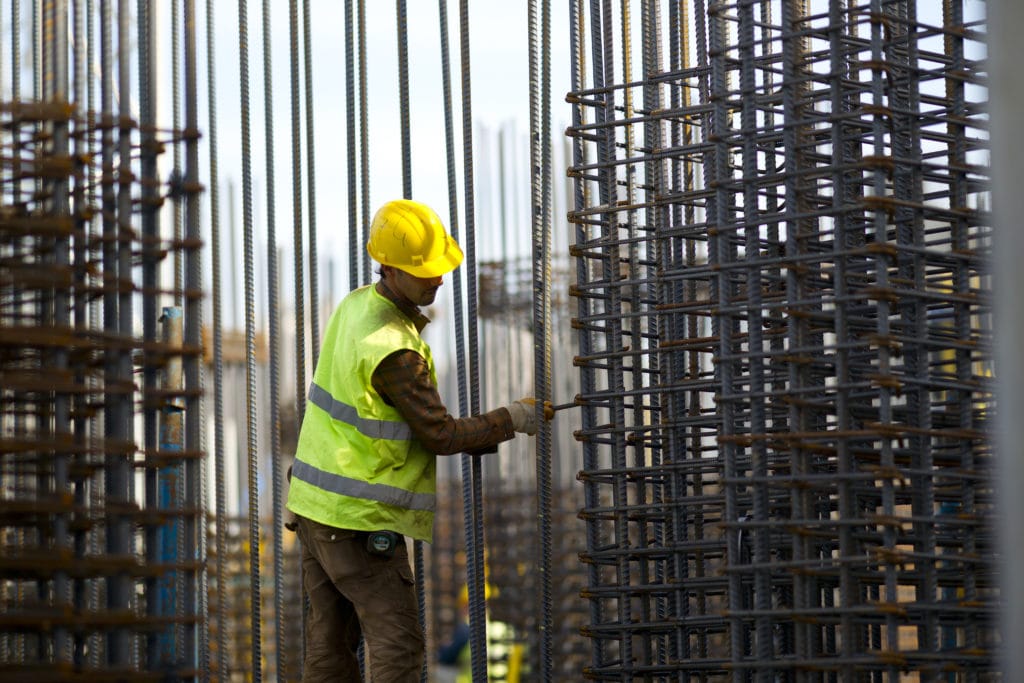What is a punch list
In most cases, a punch list is seen as a document or list of items which define in detail the work that doesn’t comply with the contract requirements, after a significant part of the project is completed. To some extent, this explanation is accurate. Nevertheless, it would be wrong to limit the importance of the punch list only to this aspect of a project.
A well-written punch list can be a powerful guide throughout the whole project as it will include every single task that should be completed. In other words, it functions both as a building plan and a warranty of quality for the whole project.
Read more: Guide to a digitised QHSE organisation
More importantly, a good punch list can pave the way for a smooth collaboration between the numerous project stakeholders (owner, contractor, subcontractor, architect). Nowadays, there are a bunch of punch list apps (including LetsBuild), which can help you with that.
Before the official completion of the project and the release of the final payment, it is crucial that all the different sides review together the entire building process and make sure that everything has been finished according to the agreed plan. It doesn’t take much to realise that a detailed punch list can save you from project disputes and costly reworks.
For that reason, it is always highly recommended that a punch list is put together before the beginning of the project. In that manner, you have all the time to address any ‘deal-breaker’ issues and resolve points of conflict before they even emerge.
If you are working (or you are about to work) with a quality contractor, setting up a punch list should be no problem at all. To the contrary, it would be seen as a way to leverage quality during the construction process.
Diving into details
By now, you might already have a good grasp of what a punch list is. Nonetheless, before we delve into more details, it would be useful to provide a few more information in regard to its function.
In short, a punch list provides the owner with the option to detain the final payment to the contractor until every task of the project is completed.
The majority of the contracts specify that a contractor should inform the project owner when they believe that their work is almost done. The contractor should also request either the owner or the architect to carry out a “pre-final” project inspection. At this point, a list of tasks is created by the contractor. This list includes tasks that should either be fixed or are still pending. This document is what we know as punch list.
As soon as the architect receives the punch list, s/he has to verify whether the project has truly got to a near-completion stage as the contractor claims. If yes, they examine whether the tasks included in the punch list have been completed, as they should, and that there is no other task left behind. In the case where some of the tasks listed in the punch list aren’t completed, the contractor can reach a resolution agreement with the project owner for the pending tasks.
Once this step is completed, the final payment can be released.
Making sure that your punch list is a success
As it is already evident, coming up with a strong punch list is no child’s play. Everyone involved both in its creation and completion should know in detail what their obligations are and work tirelessly in order to fulfill them. It goes without saying that the responsibilities of each side vary based on their role in the project. Below you can find the main points of focus for each project stakeholder:
Owner
If you are the owner/client of the project, it is always a good idea to continuously monitor the progress of the project especially when it approaches its end. Put an extra focus on inspecting the development of the operations and always be ready to ask contractors as many questions as possible.
Normally, a contractor will arrange a meeting with you in order to run through the punch list and agree on the items that will be included in it. Before you go to this meeting, make sure that you have done your due diligence and that you are fully aware of your project needs.
In that sense, you should always visit the construction site before your meeting with the contractor. Like that, you will be able to visualise the situation and know exactly what you need to be done.
Contractor
As a contractor, you should always prioritise the needs of your client. Be fully prepared to guide the client around the construction site and point out the remaining tasks on your list.
Make also sure that you have closely examined the construction site before the meeting with the owner of the project. Ideally, you should be able to show every item on the punch list, or at least most of them.
Read also: 10 important questions to ask a general contractor
Furthermore, do your best to work closely together with your subcontractors in order to detect or even better avoid costly mistakes or any mismanagement of resources. In general, having an eye for detail and being ready to take care of the tiniest bottleneck during the construction process can be the key to success.
Subcontractor
The role of the subcontractor is far more practical, as s/he is the one who will actually ensure that the items on the punch list are completed according to the contract specifications. Completing the various tasks on time is, of course, essential.
However, it’s not the only thing that a subcontractor should care about. As a subcontractor, you should always be in a position to communicate effectively with the contractor and other members of the team.

In that way, you can be confident that every problem is addressed that there is no room left for costly misunderstandings and time-consuming reworks.
Architect
Last but not least, the architect or the designer of the project. If you are the architect of a project, you will often be part of the punch list walkthrough in order to ensure that the work on site complies with what’s on the drawings. If you’re in the need for finding an architect for the project, find an architect here.
During the development of a construction project, some design changes can emerge due to client requests or certain engineering limitations. In that case, you should show flexibility and listen to the client preferences. Like that, you will be able to lead the discussion and feel safe that the design process managed to visualise successfully what the client had in mind.
Find here: Construction management 101 – The ultimate guide
Most common punch list items
Putting together and inspecting a punch list can be a long process. On top of that, based on the information above it is clear that what you are searching for in a punch list can vastly be depended on your actual role in the project. In an effort to make your life a bit easier, we present below some of the most typical items that someone can find on a punch list, which maybe you can use in your punch list template:
| Investor | Construction Technology startups in portfolio |
|---|---|
| Y Combinator | Plangrid, Airwave, BuildZoom, BulldozAIR, EquipmentShare and 8 more |
| 500 Accelerator | SupplyHog, Builk, IMERSO, ViaVolta, Betterview and 3 more |
| Brick and Mortar Ventures | BuildingConnected, HoloBuilder, Zlien, Rhumbix, ManufactOn, Serious Labs |
| Borealis Ventures | Newforma, Vico Software, FieldLens, Flux Factory, Smartvid.io, Blokable |
| Caterpillar | IronPlanet, Yard Club, Uptake Technology, Airwave, BusyBusy |
72 questions to include in a punch list
Now that we have acquired a better idea of what item categories are included in a punch list, it can be very helpful to examine a more detailed version of a punch list. Below, you can find 72 questions that could be included in a punch list as described by SucceedwithContractors.com. You can download the full list here. The questions have been divided based on the item category that they belong to:
Ceilings
- Can you notice any drywall tape joints? (examine both with the lights on and in natural light).
- Are the holes for lighting and ventilation being made properly?
- Are there any cracks in the ceiling? Check also the skylight corners.
- Is the sealing of skylights completed?
- Is the attic easily accessible? Check also if it has been insulated correctly.
- Are smoke detectors properly installed? Are they working as they should?
Walls
- Can you notice any visible tape joints which are missing paint or are not properly sanded?
- Can you spot any cracks on the door and/or windows? Check at the corners.
- Is there any screw heads burst through the gypsum board?
- Are there any nail heads burst in wood framing?
- Is the painting completed?
- Are there any crushed corners, gouges or dings?
- Do you notice any cracked wall tiles?
- Is wall covering secure at corners and wall ends?
Doors and windows
- Are there any scratches, dents or buckling on the frames?
- Do the doors close and open smoothly?
- Check the self-closing doors. Do they lock properly?
- Are all exterior doors weatherstripped?
- Check if sweeps are placed at the exterior doors.
- Check if the doors can lock and close properly.
- Do door hinges miss any screws?
- Is door threshold properly placed and sealed in order to avert water invasion?
- Can you spot any gaps between the wall and the door frame?
- Can you open and close the windows without any problems? Do they lock easily?
- Check if all door stops are properly installed.
- Do you notice any damage to the glass panes? Is there any moisture between them?
- Are the doors undercut in order to allow air movement?
Cabinets
- Can you notice any exposed screw ends at the back of your cabinets?
- What about inside your cabinets?
- Can you close and open the cabinet doors without any problems?
- Are the screws in cabinet hinges places properly?
- Is the molding properly installed? Is it nailed or glued?
- Check the quality of close rods installation. Are they installed as they should?
Counters
- Is the sink sealed properly to the countertop?
- Can you notice any gaps at countertop corners?
- Is the backsplash properly shuttered?
Flooring
- Can you notice any shred ends on the carpet?
- Check the flooring transition. Is everything put correctly?
- Are the grout joints the same size?
- Check if the floor grout is properly sealed.
- Is there any damage to the tiles (eg. cracks)?
- Has the wall base been attached correctly?
- Can you spot any cracks between the wall and the base? Between the flooring and the base?
- Can you notice any damage to flooring due to construction work?
- Are transition strips visible in the places where distinct flooring types meet?
Mechanical
- Do the exhaust fans work?
- Examine if the microwave exhaust is placed properly?
- Check if the registers and diffusers are fully-functional.
- Do you notice any problems with the installation of the thermostat(s)?
- Are the furnace filters clean?
- Check if the ductwork is properly sealed and insulated. Has the contractor cleaned it after the end of his/her work?
- Is there any noise, vibration or rattling when furnace and AC work?
- Are the appliances fully-functional?
- Is the range hood ready for use?
Plumbing
- Check if the dryer vent is fully functional.
- Are the plumbing fixtures sealed and shred correctly?
- If there is a garbage disposer, does it work?
- Can you notice any problems with the shut-off valves? Are they properly installed wherever there is a water connection (eg. bathroom, kitchen)?
- Is plumbing in the walls easily reachable?
- Do the faucets work as they should?
- Does the toilet flush as it is supposed to?
- Do you notice any malfunctions with the water heater?
- Check if traps and backflow preventers are installed in the drain.
Electrical
- Check if all the phone jacks in the place work.
- Are all cover plates installed?
- Is the installation of ceiling fans in the future possible?
- Is a wall switch for ceiling fans installed?
- Check closely if the circuits have been labeled correctly.
- Do you notice any malfunction at the garage door?
- Are cable jacks installed in the different rooms?
- Check if the irrigation clock is working properly.
- Find out where the breaker panel is placed.
A general piece of advice
Regardless of your role in a construction project, the importance of a punch list is colossal. While preparing or working on a punch list, you should always keep an eye on the future. In other words, you want to put together a clean and specific process so you can make good use of it again in upcoming projects.
That can be an investment of tremendous importance both for the present and future projects that you will be part of. What is more, the better you work on a punch list the stronger reputation you can acquire in the building world. And typically, nobody is more efficient in promoting your services than the people who have worked with you in the past.
You should never take the creation and execution of a punch list lighthearted. This applies to everybody (contractors, owners, subcontractors, architects).
It goes without saying that different projects face different challenges. Nonetheless, by setting up a straightforward detailed project monitoring and inspection procedure you can get one step closer to success.
Punch list apps – digital tools to revolutionize punch lists
The advent of digital technologies has already contributed significantly to improving the way construction stakeholders are designing and working on a punch list. By using reliable punch list software or punch list apps, during the building process, you can push for a more dynamic completion of the punch list and smarter monitoring of the whole process.
In that way, you can develop your project tasks smoothly without ever losing control of any pending requests.

Furthermore, you can effortlessly keep a close eye to the various past, ongoing and future tasks. As a result, you will end up with a much shorter and simpler punch list which can be successfully completed in no time.
At LetsBuild, we are well aware of the obstacles that often emerge during the construction process. Through our interactive Gantt Chart and the powerful real-time reporting features, we want to help you regain control of your project and increase efficiency. So no punch list can ever be a problem for you again.




